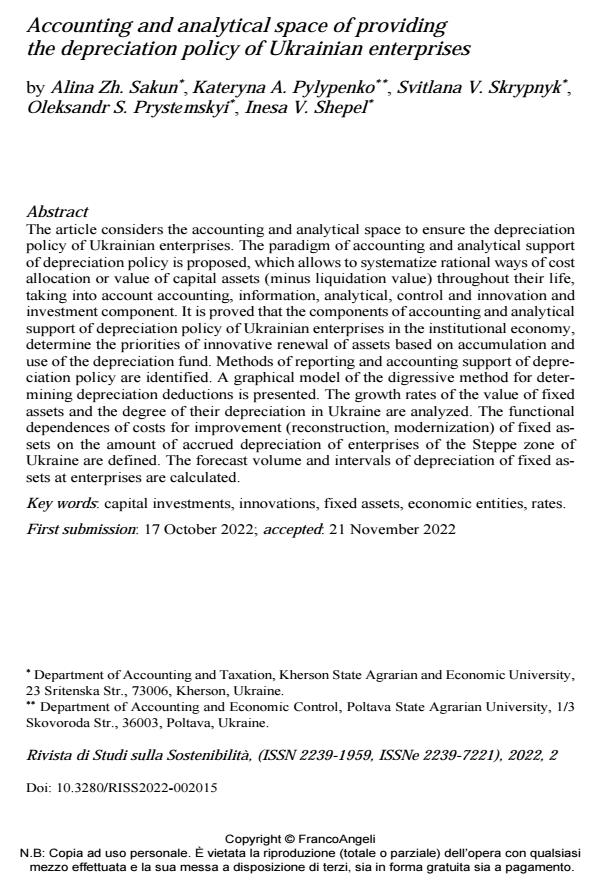Accounting and analytical space of providing the depreciation policy of Ukrainian enterprises
Titolo Rivista RIVISTA DI STUDI SULLA SOSTENIBILITA'
Autori/Curatori Alina Zh. Sakun, Kateryna A. Pylypenko, Svitlana V. Skrypnyk, Oleksandr S. Prystemskyi, Inesa V. Shepel
Anno di pubblicazione 2023 Fascicolo 2022/2
Lingua Inglese Numero pagine 24 P. 247-270 Dimensione file 492 KB
DOI 10.3280/RISS2022-002015
Il DOI è il codice a barre della proprietà intellettuale: per saperne di più
clicca qui
Qui sotto puoi vedere in anteprima la prima pagina di questo articolo.
Se questo articolo ti interessa, lo puoi acquistare (e scaricare in formato pdf) seguendo le facili indicazioni per acquistare il download credit. Acquista Download Credits per scaricare questo Articolo in formato PDF

FrancoAngeli è membro della Publishers International Linking Association, Inc (PILA)associazione indipendente e non profit per facilitare (attraverso i servizi tecnologici implementati da CrossRef.org) l’accesso degli studiosi ai contenuti digitali nelle pubblicazioni professionali e scientifiche
The article considers the accounting and analytical space to ensure the deprecia-tion policy of Ukrainian enterprises. The paradigm of accounting and analytical support of depreciation policy is proposed, which allows to systematize rational ways of cost allocation or value of capital assets (minus liquidation value) throughout their life, taking into account accounting, information, analytical, con-trol and innovation and investment component. It is proved that the components of accounting and analytical support of depreciation policy of Ukrainian enter-prises in the institutional economy, determine the priorities of innovative renewal of assets based on accumulation and use of the depreciation fund. Methods of reporting and accounting support of depreciation policy are identified. A graphical model of the digressive method for determining depreciation deductions is present-ed. The growth rates of the value of fixed assets and the degree of their deprecia-tion in Ukraine are analyzed. The functional dependences of costs for improve-ment (reconstruction, modernization) of fixed assets on the amount of accrued depreciation of enterprises of the Steppe zone of Ukraine are defined. The forecast volume and intervals of depreciation of fixed assets at enterprises are calculated.
Parole chiave:capital investments, innovations, fixed assets, economic entities, rates.
- Організаційно-методичні аспекти внутрішнього контролю витрат підприємства Олександр Пристемський, in InterConf /2023 pp.128
DOI: 10.51582/interconf.19-20.12.2023.011 - Обліково-контрольні процеси в системі управління доходами суб’єктів підприємництва Аліна Сакун, in InterConf /2024 pp.132
DOI: 10.51582/interconf.19-20.02.2024.013
Alina Zh. Sakun, Kateryna A. Pylypenko, Svitlana V. Skrypnyk, Oleksandr S. Prystemskyi, Inesa V. Shepel, Accounting and analytical space of providing the depreciation policy of Ukrainian enterprises in "RIVISTA DI STUDI SULLA SOSTENIBILITA'" 2/2022, pp 247-270, DOI: 10.3280/RISS2022-002015